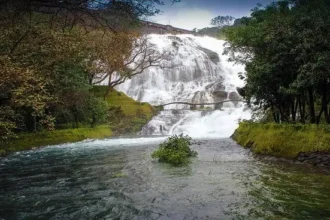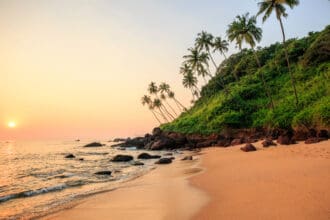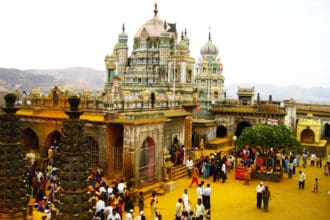Kolhapur, a city steeped in history, culture, and spirituality, is one of Maharashtra’s most enchanting destinations. Nestled between the Sahyadri mountain ranges and lush green landscapes, this vibrant city offers a perfect blend of ancient traditions and modern charm. From majestic temples to serene lakes, Kolhapur has something for every traveler. In this article, we will explore the top 5 places to visit in Kolhapur , providing you with an immersive experience that highlights the city’s unique allure.
Whether you’re a history enthusiast, a spiritual seeker, or simply someone looking to unwind amidst breathtaking scenery, Kolhapur promises an unforgettable journey. Let us take you through its most iconic landmarks, hidden gems, and everything else you need to know to make your trip memorable.
1. Mahalaxmi Temple: The Spiritual Heart of Kolhapur
A Divine Abode of Goddess Mahalaxmi
The Mahalaxmi Temple is not just a religious site; it is the very soul of Kolhapur. Dedicated to Goddess Mahalaxmi, the presiding deity of the city, this temple is one of the Shakti Peethas in India, making it a revered pilgrimage destination. Built during the Chalukya dynasty in the 7th century, the temple reflects exquisite architecture that combines Hemadpanthi style with intricate carvings and sculptures.
Architectural Marvels
As you step into the temple complex, you’ll be mesmerized by its towering spires, ornate pillars, and sacred sanctum. The idol of Goddess Mahalaxmi, adorned with gold and precious stones, exudes divine energy. The temple’s unique feature is its east-facing entrance, which symbolizes the rising sun and prosperity. The main structure consists of three sanctums dedicated to Goddess Mahalaxmi, Goddess Mahasaraswati, and Goddess Mahakali, representing the trinity of power, wisdom, and destruction respectively.
The outer walls are adorned with detailed carvings depicting scenes from Hindu mythology, including tales of Lord Vishnu and Goddess Lakshmi. Each carving tells a story, offering visitors a glimpse into the rich cultural heritage of the region. The temple also features several smaller shrines dedicated to other deities, such as Lord Ganesh and Lord Hanuman, adding to its spiritual significance.
Spiritual Significance
Devotees believe that visiting the Mahalaxmi Temple brings blessings of wealth, health, and happiness. Thousands of pilgrims flock here daily, especially during Navratri, when the temple comes alive with vibrant celebrations, devotional hymns, and cultural performances. During these nine days, the temple witnesses a surge in footfall, with devotees participating in special pujas, aartis, and processions.
The temple’s annual fair, known as Brahmotsavam , is another major event that draws crowds from across the country. This ten-day festival includes elaborate rituals, chariot processions, and traditional music and dance performances. Devotees often tie coconuts at the temple gates as offerings, believing it will fulfill their wishes.
Travel Tips
- Best Time to Visit: Early mornings or late evenings to avoid crowds.
- Dress Code: Modest attire is recommended. Avoid wearing revealing clothes.
- Photography: Photography inside the temple premises is prohibited.
- Accessibility: The temple is wheelchair accessible, but some areas may require assistance due to uneven surfaces.
Nearby Attractions
In addition to the Mahalaxmi Temple, there are several other attractions worth exploring nearby:
- Tryambuli Devi Temple : Located close to the Mahalaxmi Temple, this shrine is dedicated to Goddess Tryambuli, another form of Goddess Durga.
- Rankala Lake : Just a short drive away, Rankala Lake offers a peaceful retreat with picturesque views.
- Kolhapur Museum : A must-visit for history buffs, this museum houses artifacts dating back to the Maratha era.
Nearby Hotels and Restaurants
For accommodation, consider staying at Hotel Regent , Sayaji Hotel , or Kolhapur Residency , all of which offer comfortable rooms and excellent amenities. For authentic Maharashtrian cuisine, visit Shree Krishna Restaurant , famous for its Kolhapuri misal pav, or Ganesh Bhojanalay , known for its flavorful thalis.
2. Rankala Lake: A Serene Escape Amidst Nature
A Picturesque Retreat
Rankala Lake , one of Kolhapur’s most iconic landmarks, is a man-made lake believed to have been constructed during the reign of the Shilahara dynasty. Surrounded by lush greenery and dotted with small temples, this tranquil spot is perfect for nature lovers and photography enthusiasts. The lake spans over 30 acres and serves as a popular recreational area for locals and tourists alike.
Activities to Enjoy
Take a leisurely stroll along the lake’s perimeter, rent a paddle boat to enjoy the water, or simply sit on the benches while soaking in the serene ambiance. During sunset, the reflection of the sky on the lake creates a mesmerizing sight. Boating facilities are available throughout the day, allowing visitors to glide across the calm waters and admire the surrounding beauty.
For those seeking adventure, the nearby jogging track and cycling paths provide opportunities for physical activity. Families often gather here for picnics, making it a lively yet peaceful environment. On weekends, the area buzzes with activity as vendors set up stalls selling snacks, toys, and souvenirs.
Historical Legends
Legend has it that the lake was formed after Lord Krishna slew the demon Rankasura. Locals often narrate tales of how the area was once a battleground, adding a mystical charm to the location. According to folklore, Rankasura had kidnapped thousands of women, and Lord Krishna, disguised as a cowherd, defeated him to rescue them. The lake is said to have emerged from the spot where Rankasura was vanquished.
Travel Tips
- Best Time to Visit: Late afternoon for stunning sunset views.
- Facilities Available: Boating, food stalls, and seating areas.
- Safety Precautions: Supervise children near the water, as the edges can be slippery.
Nearby Attractions
- Panhala Fort : Located approximately 20 kilometers away, Panhala Fort offers panoramic views and historical insights.
- Radhanagari Wildlife Sanctuary : Ideal for wildlife enthusiasts, this sanctuary is home to diverse species of flora and fauna.
- Kolhapur Palace (New Palace) : A stunning example of Indo-Saracenic architecture, the palace now houses a museum showcasing royal artifacts.
Nearby Hotels and Restaurants
Stay at Hotel Raviraj or The Fern Residency for comfortable lodging. Both properties are conveniently located and offer modern amenities. For dining options, head to Green Leaf Restaurant , which specializes in vegetarian dishes, or Sai Palace Family Restaurant , known for its North Indian delicacies.
3. Panhala Fort: A Testament to Maratha Valor
An Architectural Masterpiece
Perched atop the Sahyadri hills, Panhala Fort stands as a symbol of Maratha pride and resilience. Built in the 12th century by the Shilahara dynasty, the fort later became a stronghold of Chhatrapati Shivaji Maharaj. Its strategic location offers panoramic views of the surrounding valleys and plains, making it a favorite among history enthusiasts and adventure seekers.
Exploring the Fort
The fort spans over 7 kilometers and houses numerous structures, including watchtowers, bastions, and secret escape routes. Key attractions within the fort include:
- Teen Darwaza : A massive triple-arched gateway that served as the main entrance to the fort.
- Andhar Bavadi (a hidden well): Designed to ensure a steady water supply even during sieges, this underground well is a marvel of ancient engineering.
- Kalavantinicha Mahal (Palace of Courtesans): Once used by royal courtesans, this palace features intricately carved pillars and spacious halls.
Other notable sites within the fort complex include the Sajja Kothi , a tower where Chhatrapati Shivaji Maharaj reportedly spent time strategizing military campaigns, and Pavankhind , the site of a historic battle where Baji Prabhu Deshpande sacrificed his life to protect Shivaji Maharaj.
Historical Insights
Panhala Fort played a crucial role in several battles fought by the Marathas. Its underground tunnels, designed for emergency evacuations, are still intact and open for exploration. These tunnels stretch for miles and were used to transport supplies and troops discreetly. Visitors can walk through parts of these tunnels, experiencing firsthand the ingenuity of ancient architects.
During the monsoon season, the fort transforms into a verdant paradise, with waterfalls cascading down the hillsides and wildflowers blooming in abundance. This makes it an ideal destination for nature lovers and photographers.
Travel Tips
- Best Time to Visit: Monsoon season for lush greenery and cool weather.
- What to Carry: Comfortable walking shoes, plenty of water, and sunscreen.
- Guided Tours: Consider hiring a local guide to gain deeper insights into the fort’s history.
Nearby Attractions
- Sajja Kothi : Offers breathtaking views of the valley below.
- Pavankhind : A historically significant site commemorating the bravery of Baji Prabhu Deshpande.
- Amba Ghat : Known for its scenic beauty and trekking trails.
Nearby Hotels and Restaurants
Choose from Hotel Sai Heritage or Fort View Resort for accommodations. Both properties offer cozy rooms and stunning views of the surrounding landscape. For meals, try Amba Bhog Restaurant , which serves authentic Maharashtrian dishes, or Chaitanya Paranthas , famous for its stuffed parathas.
4. Jyotiba Temple: A Beacon of Faith
A Sacred Pilgrimage Site
Located on the outskirts of Kolhapur, the Jyotiba Temple is dedicated to Lord Jyotiba, an incarnation of Lord Vishnu. Perched atop a hill, the temple offers breathtaking views of the surrounding landscape and attracts devotees from across the country. The climb to the temple is steep but rewarding, as the summit provides panoramic vistas of Kolhapur and its environs.
Religious Importance
According to legend, Lord Jyotiba defeated the demon Ratnasur, restoring peace and harmony to the region. The temple’s annual fair, held during Vaishakha Purnima, draws thousands of visitors who come to seek blessings and participate in festivities. During this time, the temple premises are decorated with colorful lights, and cultural programs are organized to entertain pilgrims.
The temple’s architecture is equally impressive, featuring intricate carvings and ornate domes. Inside, the idol of Lord Jyotiba is adorned with gold and precious stones, radiating divine energy. Devotees often perform abhishekams (ritual baths) and offer flowers and sweets as part of their prayers.
How to Reach
The temple can be accessed via a steep climb or a motorable road. While the trek might be challenging, the sense of accomplishment upon reaching the summit is unparalleled. For those who prefer a more relaxed approach, vehicles can drive up to the base of the hill, from where a shorter staircase leads to the temple.
Travel Tips
- Best Time to Visit: Early morning for a peaceful darshan.
- Things to Carry: Snacks, water bottles, and appropriate footwear.
- Health Considerations: If you have mobility issues, opt for the motorable route instead of climbing.
Nearby Attractions
- Kasba Ganpati Temple : One of the oldest temples in Kolhapur, dedicated to Lord Ganesh.
- Bhudargad Fort : A lesser-known fort offering trekking opportunities and historical insights.
- Shahu Museum : Houses artifacts related to the erstwhile rulers of Kolhapur.
Nearby Hotels and Restaurants
Opt for Hotel Panchshil or Hotel City Pride for your stay. Both hotels are centrally located and offer clean, comfortable rooms. For local delicacies, visit Shiv Sagar Restaurant , renowned for its spicy Kolhapuri curries, or Mitra Café , which serves delicious street food.
5. Radhanagari Wildlife Sanctuary: A Haven for Nature Enthusiasts
Biodiversity at Its Best
Established in 1958, the Radhanagari Wildlife Sanctuary is Maharashtra’s first wildlife sanctuary. Spread across 351 square kilometers, it serves as a natural habitat for diverse flora and fauna, including tigers, leopards, bison, and various bird species. The sanctuary is nestled amidst the Western Ghats, ensuring a rich ecosystem teeming with life.
Wildlife Safaris and Trekking
Embark on a thrilling jeep safari to spot elusive animals or indulge in birdwatching amidst pristine forests. The sanctuary is home to over 260 species of birds, making it a paradise for ornithologists. Some of the commonly spotted avian species include the Malabar pied hornbill, Indian giant squirrel, and crested serpent eagle.
For adventure enthusiasts, the sanctuary offers trekking trails that wind through dense jungles, rocky terrains, and cascading waterfalls. Popular treks include the Amba Ghat Trek and the Dajipur Bison Trail , both of which provide opportunities to observe wildlife up close.
Conservation Efforts
The sanctuary plays a vital role in conserving endangered species like the Indian giant squirrel and Malabar pied hornbill. Visitors are encouraged to follow eco-friendly practices to preserve its ecological balance. Strict regulations are in place to minimize human impact, including bans on littering and restricted access to sensitive areas.
Travel Tips
- Best Time to Visit: Winter months (October to February).
- Entry Fees: Check official guidelines before planning your visit.
- Guidelines: Maintain silence during safaris to avoid disturbing animals.
Nearby Attractions
- Amba Ghat : Known for its scenic beauty and trekking trails.
- Dajipur Bison Sanctuary : Another wildlife haven located nearby.
- Kumbhojgiri Hill Station : Offers cool weather and panoramic views.
Nearby Hotels and Restaurants
Consider staying at Hotel Kohinoor Executive or Hotel Grand Central . Both properties are budget-friendly and offer basic amenities. For dining, check out Hotel New Gurukrupa or Swad Veg Restaurant , both of which serve wholesome meals.
Travel Tips for Exploring Kolhapur
- Transportation: Hire a private cab or use local buses to navigate the city.
- Local Etiquette: Respect cultural norms, especially when visiting religious sites.
- Weather Considerations: Summers can be hot, so plan outdoor activities accordingly.
- Currency Exchange: Most establishments accept digital payments, but carrying cash is advisable.
- Language Barrier: While Marathi is the primary language, English and Hindi are widely spoken.
Conclusion
Kolhapur is a treasure trove of history, spirituality, and natural beauty. Whether you’re marveling at the grandeur of the Mahalaxmi Temple, enjoying the tranquility of Rankala Lake, or exploring the rugged terrains of Panhala Fort, every moment spent in this city leaves a lasting impression. With our comprehensive guide to the top 5 places to visit in Kolhapur , we hope you’re inspired to embark on a journey that blends tradition with adventure.
Frequently Asked Questions (FAQs)
- What is the best time to visit Kolhapur?
- The ideal time is between October and March when the weather is pleasant.
- How do I reach Kolhapur?
- Kolhapur is well-connected by road, rail, and air. The nearest airport is Kolhapur Airport.
- Is Kolhapur safe for solo travelers?
- Yes, Kolhapur is generally considered safe for all types of travelers.
- What are some must-try dishes in Kolhapur?
- Don’t miss Kolhapuri misal pav, tambda rassa, pandhra rassa, and kheema samosas.
- Are there any entry fees for these attractions?
- Most temples and lakes are free to enter, but some forts may charge nominal fees.
- Can I visit all five places in one day?
- It’s possible but would require careful planning due to distances between locations.
- What languages are spoken in Kolhapur?
- Marathi is the primary language, but Hindi and English are widely understood.
- Are guided tours available for these sites?
- Yes, many travel agencies offer guided tours for convenience.
- What should I wear while visiting temples?
- Opt for modest clothing that covers shoulders and knees.
- Are pets allowed inside these tourist spots?
- Pets are usually not permitted inside temples and sanctuaries.

















